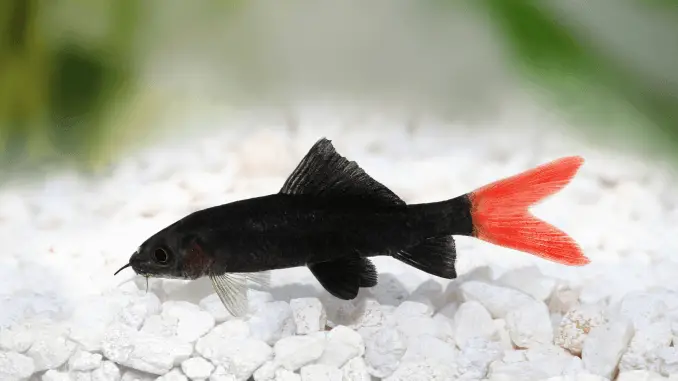
The red tail shark is a medium-sized freshwater fish of the Cyprinidae family.
Red tail sharks are popular with fishkeepers because of their shark-like resemblance and feisty personalities. They are hardy, but the fish’s territorial nature makes them moderately difficult to care for.
TABLE OF CONTENTS
Red Tail Shark Facts & Overview
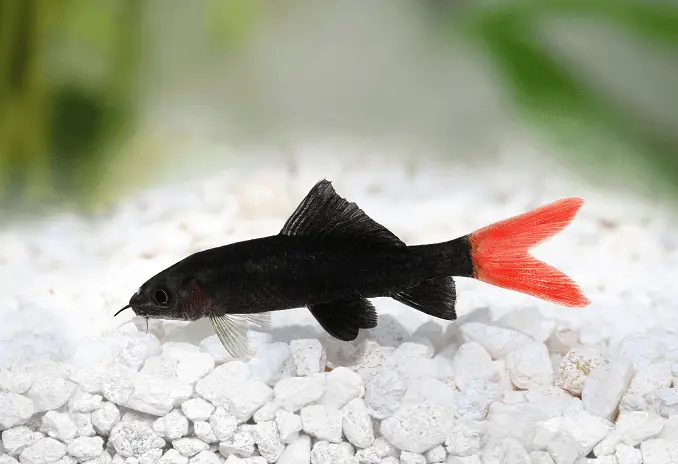
| Scientific name: | Epalzeorhynchos bicolor |
| Common names | Red-tailed black shark, redtail sharkminnow, red tailed labeo |
| Distribution: | Thailand |
| Size: | Up to 6 inches |
| Life expectancy: | 5–8 years |
| Color: | Black with a red or orange tail |
| Diet: | Omnivore |
| Temperament: | Semi-aggressive, territorial |
| Minimum tank size: | 55 gallons |
| Temperature: | 72°–79°F (22°–26°C) |
| pH: | 6.0–8.0 pH |
| Hardness: | 5–15 dGH |
| Care level: | Intermediate |
| Breeding: | Egg layer |
Origin
Red tail sharks, also known as redtail sharkminnows, are native to the Chao Phraya basins in Thailand. These fish inhabit lowland streams, rivers, and creeks with rocky or sandy substrate.
Red tail sharks are critically endangered in the wild and were thought to be extinct until 2011.
Captive-bred red tail sharks are still abundant and readily available in local pet stores. The International Union for Conservation of Nature (IUCN) has advised on conversation actions to preserve this fish in its natural environment.
Adult Size & Lifespan
Red tail sharks grow up to 6 inches in length, and females are larger and wider than males. These fish live to between five and eight years old in captivity. Females and males have similar life expectancies.
Stable water parameters and a spacious tank help red tail sharks live long and fulfilling lives.
Availability
Red tail sharks are easy to find in pet stores and online aquarium stores. The fish cost between $3 and $7 per fish on average.
You can find red tail sharks at:
Buying directly from a reputable breeder ensures the red tail shark is healthy and has been raised in sanitary conditions. Avoid breeders and shops selling red tail sharks for less than $3 because a cheap fish is more likely to be sick or poorly treated.
Appearance & Behavior
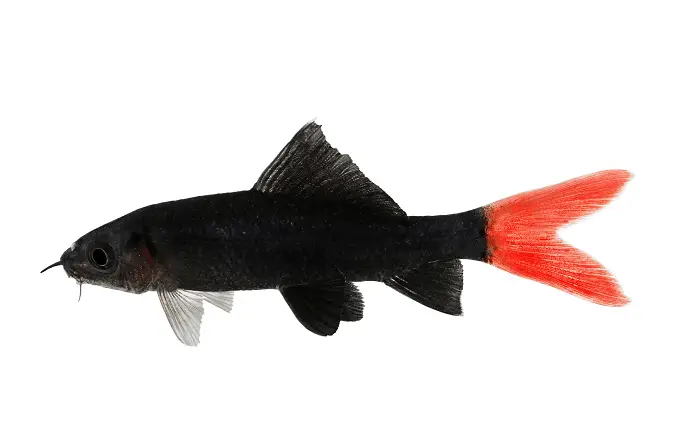
The red tail shark gets its name from its shark-like appearance and distinctive red tail. Red tail sharks are territorial and can be aggressive toward other fish, including their own kind.
Colors, Patterns, Fins, and Sex Differences
Red tail sharks have streamlined, jet-black bodies with vibrant red forked tails. The snout of the red tail shark is pointed and the dorsal fin is triangular-shaped. Some red tail sharks have a white tip at the top of their dorsal fins. They may lose their tail hue when stressed or sick, or when water conditions are poor.
Male adult red tail sharks have brighter coloration, slimmer bodies, and a more pointed dorsal fin than females. The fish develop noticeable differences when they have reached maturity (15 months old).
Red tail sharks are similar in appearance to rainbow sharks. Both species are part of the Cyprinidae family and have red tails. The main physical difference is that rainbow sharks have red fins, whereas red tail sharks have black fins.
Typical Behavior
The red tail shark is renowned for its feisty personality. Red tail sharks establish territories and often harass and chase other fish that enter these spaces. A spacious tank with lots of hiding spots and vegetation can reduce the fish’s aggressive tendencies.
Red tail sharks are active, fast swimmers that dart around the bottom of the tank. They are aggressive to fish of their own kind, preferring to live alone.
Juvenile red tail sharks are more timid than adults and need lots of hiding spots to feel safe and comfortable. Red tail sharks are nocturnal, meaning they’re most active at night.
These fish should only be housed with fish that can keep to themselves because red tail sharks bully small, slow-moving fish, especially when competing for food.
Red Tail Shark Care & Tank Requirements
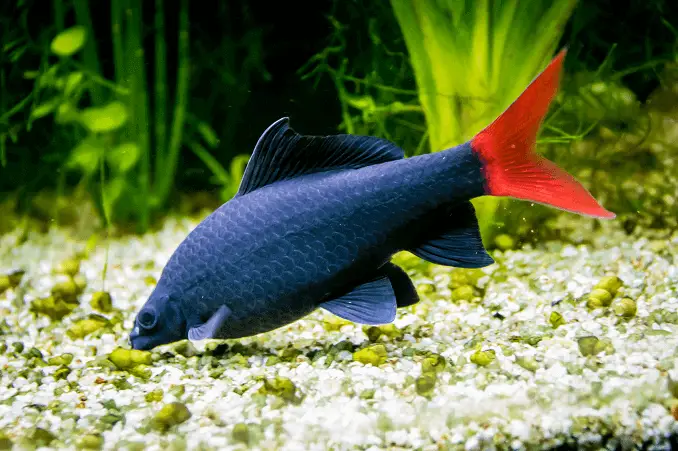
Red tail sharks are hardy but aggressive and are moderately difficult to care for. In the pet trade, red tail sharks are captive bred. However, replicating elements of the red tail shark’s natural habitat helps the fish feel happy, secure, and comfortable.
Feed red tail sharks live or frozen foods, such as bloodworms and daphnia, to enhance coloration.
Habitat and Tank Requirements
Red tail sharks prefer fast-moving bodies of water with dense vegetation and rocky substrate.
They need a high amount of dissolved oxygen in the water, which can be created with air stones.
Tank Conditions
The red tail shark’s preferred tank conditions are:
| Water type: | Freshwater, with regular partial water changes to maintain cleanliness and keep parameters stable |
| Tank size: | A 55-gallon elongated tank is best. Red tail sharks are active bottom-dwellers and need ample space to roam. An elongated tank provides more room for exploration and increases oxygen levels in the water |
| Water temperature: | 72°–79°F (22°–26°C) |
| Substrate: | Incorporate rocks and pebbles of varied sizes to mimic the red tail shark’s natural habitat. Avoid fine gravel as the red tail shark may accidentally ingest this when scavenging. A dark-hued substrate helps the fish feel comfortable and shows off its vibrant red tail |
| Tank setup: | Decorate the aquarium with fine leaved plants, caves, and driftwood to provide hiding spots and areas for the red tail shark to set up its territory. Floating plants, such as java moss, water wisteria, and hornwort, keep the water shaded |
| Acidity: | 6–8 pH |
| Water hardness: | Soft, with a hardness between 5–15 dGH |
| Filter: | Opt for a filtration system that generates a strong current. Red tail sharks are accustomed to fast-flowing water and often swim against the current to expel excess energy |
| Bubbler: | A small weighted bubbler (air stone) helps to diffuse air into the aquarium |
| Lighting: | Avoid harsh lighting and direct sunlight. Red tail sharks are nocturnal and active in dark and dim environments |
| Water heater: | Yes, to maintain consistent, warm water temperatures |
Red tail sharks thrive in water with stable parameters, plants, a strong filtration system, and lots of space to explore.
A tank that’s too small can cause red tail sharks to become stressed and aggressive. Fishkeepers should invest in a secure, weighted lid, as red tail sharks are known to jump out of the tank.
Disease
The most common diseases that affect red tail sharks are fin rot and Ich. Most diseases are preventable with ideal water parameters, a healthy diet, and regular water changes. Water fluctuations should be kept to a minimum.
Inspect red tail sharks daily for signs of illness. Common symptoms include loss of appetite, lethargy, a change in swimming patterns, and deterioration of scales or fins.
Ich
This freshwater fish disease is caused by the external parasite Ichthyophthirius multifiliis. The signs of ich are salt-like white spots on the fish’s body, appetite loss, and flashing, where the fish rubs against objects.
Red tail sharks with ich must be quarantined in a separate, clean tank. Water temperature should then be gradually increased by a few degrees to eliminate the parasite.
Fin Rot
Fin rot is an infection caused by poor water conditions or improper oxygen levels. Symptoms include tattered and frayed fins, coloration loss, and inflammation at the base of the fins.
Fin rot is treatable with antibiotics. Keeping water clean and at the appropriate parameters helps prevent fin rot.
Tank Mates
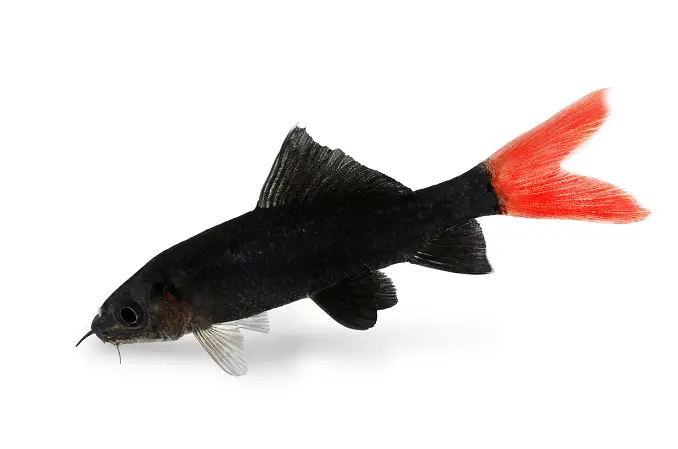
The red tail shark is semi-aggressive and requires boisterous, top-dwelling, medium-sized tank mates that can match the shark’s hot temper.
Red tail sharks are solitary fish, and shouldn’t be housed together unless the tank is spacious enough for each red tail shark to have its own territory.
These species make great tank mates for red tail sharks:
- Bala sharks
- Barbs (tinfoil, rosy, and tiger)
- Cichlids
- Danios (giant and zebra)
- Gouramis (pearl, blue, and paradise)
- Tetras (neon and glowlight)
Red tail sharks tend to bully slow-moving, timid, long-finned, and small fish, like angelfish, fancy guppies, and bettas. Invertebrates shouldn’t be added to the tank because red tail sharks eat them.
Diet and Feeding
These fish are omnivores and enjoy scavenging for food. The fish have a down-turned mouth which they use to scrape algae from rocks. In the wild, a red tail shark’s diet consists of insects, crustaceans, plant matter, and worms.
Red tail sharks should be fed a varied diet of pellets, live or frozen foods, and vegetables like zucchini and blanched peas. Algae wafers are a nutritious food option for this bottom-dwelling fish. Live food can make the red tail shark’s coloration more vibrant. Ideal live and frozen foods are bloodworms, daphnia, and brine shrimp.
Feed the red tail shark once every couple of days, ideally between dusk and dawn. Food that sinks to the bottom of the tank, like sinking pellets, is best for red tail sharks.
Breeding
Red tail sharks are egg layers. Breeding red tail sharks in a home tank setup is virtually impossible because the fish is aggressive toward others of its kind.
Red tail sharks available in the pet trade are bred in commercial farms, where hormones are used to encourage breeding.
Should You Get a Red Tail Shark for Your Aquarium?
The red tail shark is a robust and lively fish with a fierce personality. Red tail sharks are moderately difficult to care for and need at least a 55-gallon tank or bigger.
You should get a red tail shark if you have a large enough tank with caves and plants for the red tail shark to retreat to, but with enough open space for the fish to roam freely. Red tail sharks aren’t suitable in community tanks housing small, timid, or long-finned fish.
With the right care and environment, red tail sharks are captivating fish that’ll bring a splash of color to the aquarium.

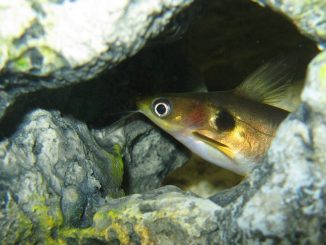
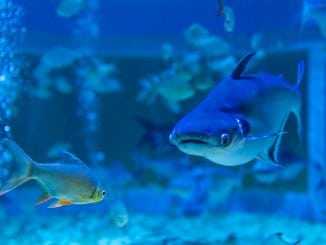
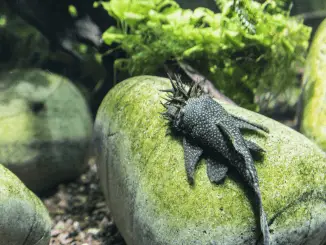
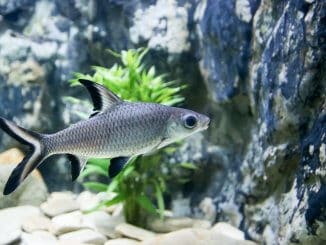
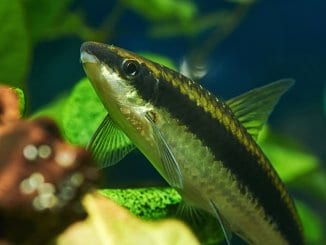
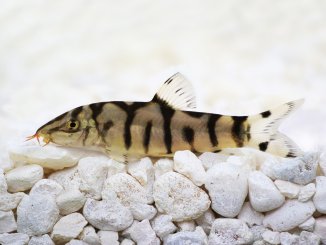
This helped me so much. I have 2 10cm red tails in my 60 liter aquarium, im gonna go put them in my 160 liter aquarium instead then.
My red tailed shark looks sick, on its left side it looks like a big Tumor ! RIgbo side is normal! Is it dying?
Hi Paula, sorry to hear this! I think your best bet would be to get a fish veterinarian to take a look. Let me know how you get on. Thanks, Robert
I have a 125g tank with silver dollars,tiger Barb’s,danios, cichlids,Cory catfish, African cichlids, an upside down catfish, irridescent shark,pleco, and Columbian pictus catfish, and wanting to add my redfinned shark in with them. Does anyone know if these tankmates are compatible with this shark? Even though I have an irridescent shark. Most fish are similar size except silver dollars and cichlids.
I have one with my tiger Barb’s 2 rapheal cats electric blue acara large sail fin pleco 4 Chinese algea eaters.
I have a red tail black shark in a community tank. My tank is a 30 gal long and I have about 5 large rocks (35lbs) at one end. Have had the shark since it was about 6cm and it is now about 12 cm long. He is a big sissy and afraid of his shadow.. or is it my shadow. Most active when lighting is low. He has claimed the pile of rocks as his territory and will chase away any Panda Corys or Julii Corys that come inside. He is not very aggressive towards the Espi Rasboras or the Tetras at all. He is the largest fish in the tank and a great show piece.
I have a 20 gallon tank and I would love to have 2 sharks I have a red tail a few days only but looking to put in another sharks now which sharks can I place with the red tail
Hi Steve, any sharks you add will need to be robust and fast. Another shark you could include is the Bala Shark. Thanks, Robert
Steve a 20g tank is small for one red tail. I would NOT advise adding ANY other shark. I also would NOT get a bala shark unless you have a 150g or bigger. Please do not add any sharks to a 20g tank. I would advise a community tank with nothing bigger than some barbs. Other fish in similar size to barbs or smaller. Maybe a bristle nose pleco for the bottom (do NOT get a common pleco)
I do not recommend putting any other Red finned sharks with him. They are aggressive and will stress the other sharks out. I have learned from experience, if they are in a HUGE school together and have been its different. Especially if they have established the tank as theirs.
I have four guppies I thought that they would swim all over my tank but of course they stay at the top I want to get a rainbow shark I had two but they both died I love how they look and how they swim at the bottom of the tank but can I get another one and put them in my tank with my guppies. I don’t want to stress any of my fish out.
Hi Cat, Guppies are quite a peaceful fish so I’d avoid housing them with Red Tail Sharks. You might want to add Danios or Tetras to the tank with Red Tail Sharks instead. Thanks, Robert.
I’ve had a red tail for several years,band he is an anti-social grumpy pants. He never comes out of his stump, at least not when anyone is awake! I suppose he comes out at night to eat…the only part of him we ever see is his red tail sticking out of the stump.
Hi, I am in the process of seting up a freshwater planted tank. It will be 2m long x 70cm wide x 50cm tall. And I can’t decide what fish to put in it. First I thought to put a ton of guppies but I can’t get them all to be the same color so that option is discarded. Now the candidates are:
-Red tails are my favourites and would like to ad 5 (at least).
-Zebra plecos (Just read 🙁 not compatible with red tails).
-Bala sharks
-Clown loaches
Can you please tell me in that tank which would be compatible, and how many should I house at a time? In what order should they be introduced to avoid fights. Thanks for taking the time to put up so much info, this site is amazing!!!
Hi Mike, Thanks so much for the great feedback. You’d be better served looking at one of the online aquarium stocking calculators. They’ll give you a good idea of which fish are compatible and how many you can keep in your tank. Thanks, Robert.
Just bought two silver red tailed sharks yesterday. Today they were chasing each other, batting heads and trying to bite each
other mouth to mouth. Is this Normal behavior? Its been a long time since I had a tank and am just getting back into the
hobby. Ive had kuli loaches, places, Cory catfish, betas, guppies, in the past. I also have an outside pond with goldfish
and KOI – the German ones.
Hi Joan, you should only keep one of these per tank as they are extremely territorial. If you are keeping them in one tank, you’ll need a much larger tank with plenty of hiding places. Thanks, Robert
I have a redtail and a rainbow shark so far so good..i also have plecos and cichlids which I read are not compatible…I have a big tank (125g) and lots of hiding spots…and i have been keeping an eye. What behavior should i watch for to indicate i need to separate?
Hi Liz, any signs of aggression, or fighting. Equally watch out for any fish which are being more shy than usual, not eating etc. Many thanks, Robert
When does the shark reach full size?
Hi Kim, it really depends on the individual fish but it usually takes around 1 year for these fish to grow to around 4 inches long. Thanks, Robert
I have a red tailed shark he’s over 4 years old now he lives in a 125 litre tank with a super red bristlenose who I’ve had for 4 years as well as 8 rummy nose tetras ,3 neon tetras and 1 bronze cory .. prev had 4 corys but they’ve now sadly passed one by one after many years .. the tank has always been peaceful , I’m looking to restock some corys would I be able to have another type or should I stay with bronzes ? Plus could I up the number of neons as these were given me many years ago ? I run a huge outside filter as well as well as good sized inside filter & often do water changes so wondering if could add back to tank and what with thanks ?
Can i put angel fish with my red tail shark? if so how many should i purches?
I have a redtail with my angel fish and have had no issues
Hi do I put my shark in first if I am going to add more fish or do I add the fish then shark at a later date ?
I have a red tailed black shark in my tank with other community fish and a catfish. I’ve had no problems until recently when I’ve lost several guppy’s and neons. When I say lost I mean lost, there are no signs of them. Any idea what’s happening to them?
Why Algae eaters can I put with my red tail
I have a red tail and I was wondering what other fish I could have with it
right now I have 3 tetras,2 angel fish and my red tail.
Also, could I put dalmatian moleys with my red tail?
Hello Mr.Kim,
I have two red tailed and red finned shark. It is in my 2 feet by 2 feet aquarium and was good these days after changing the water in the tank and kept a new toy where it had good place for hiding. As it did not come for eating I removed the toy. Now it becomes more scary and always stay beneath the tank on the stones. When any fish touches or little sound comes it hits itself on the glass wall or on the rocks. It has its food rarely. What to do? I am little worried about, as it seems dying. It shows sometimes unusual behaviour by falling from top water to bottom as dead body and lays upside down for some 2 to 3 minutes and then again becomes little normal and continues its bottom living. I need your advice to recover him.
Are Cory’s alright to keep with red tail sharks and if so how many sharks go together or just get one
Thanks
Kept 2 rainbow shark in a community tank years ago, chased each other about, then one day they came out and displayed to each other after that on regular thing.
Hi I just bought a red tail and he’s a little scared of everything and I got a bigger tank 10 gallons and it needs to set so I have him in a 1 gal is that ok
I have a red fin shark. It’s in a 50 gallon tank with 5 tetras and 1 other bottom fish i don’t know what it is. This red fin shark I have had for about 9 years.
i have a 125 gallon tank with 2 oscars approximatly 7 inches long 1 pleco about 8 inches and 1 redtailed shark about 3 inches there is nice size driftwood at 1 end and rock caves in middle. Wondering about adding a bala shark or more red tailed sharks or is there any other interesting and safe species to add
I have a Red tail shark that is loosing his scale. He is active and eating . He is with Cichlids